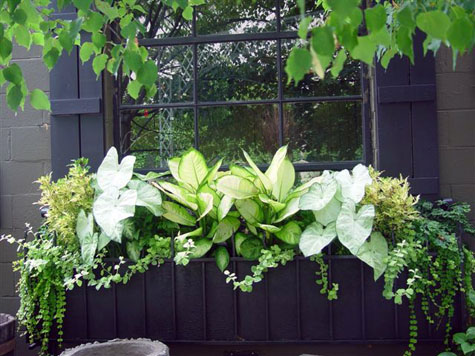 Rob decides when we will have spring. Ha. He knows just like every other gardener that the arrival of spring is attended by many false starts and deceptive signs. And at just that moment when you feel you might black out from the last of the miserable weather, nature switches on the light. But when you have a shop devoted to fine, entertaining, antique, vintage, contemporary and irresistible ornament for the gardening season to come, you do what makes sense. You pick a date, and be ready. We go on hiatus mid January to fix up, repaint and restyle. March 1 is our first day of spring. Containers from Europe jostle their way in between a steady stream of freight shipments from all over the US. The spring collection takes weeks to display. Rarely do we dot the last i and cross the last t in time, but we are ready for company.
Rob decides when we will have spring. Ha. He knows just like every other gardener that the arrival of spring is attended by many false starts and deceptive signs. And at just that moment when you feel you might black out from the last of the miserable weather, nature switches on the light. But when you have a shop devoted to fine, entertaining, antique, vintage, contemporary and irresistible ornament for the gardening season to come, you do what makes sense. You pick a date, and be ready. We go on hiatus mid January to fix up, repaint and restyle. March 1 is our first day of spring. Containers from Europe jostle their way in between a steady stream of freight shipments from all over the US. The spring collection takes weeks to display. Rarely do we dot the last i and cross the last t in time, but we are ready for company.
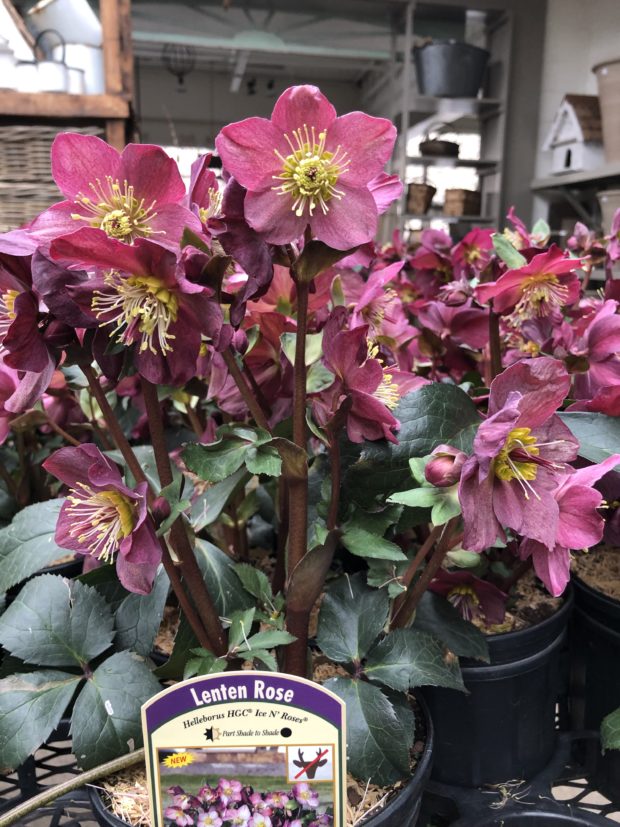 Nature takes her own sweet time deciding when to finally pull the plug on winter. Nature is the queen of false starts. The change of the season-a big fluid situation. Every gardener I know stays tuned in to that station. We are having bitterly and unseasonably cold temperatures this week. But Rob says spring is here, and we believe him. Not to mention all of our clients that have braved the cold to come in anyway, and shop. We have a greenhouse chock full of gorgeously grown hellebores in bloom. David and Karen took a trip south in February to load up plants from a number of growers. They are perfectly happy in flower in our greenhouse at 50 degrees. Their blooms are a sure sign that early spring is nigh. They handle the cold and blustery March and April weather with aplomb. Until it is safe to plant outdoors, they are perfectly happy on a sunny window sill.
Nature takes her own sweet time deciding when to finally pull the plug on winter. Nature is the queen of false starts. The change of the season-a big fluid situation. Every gardener I know stays tuned in to that station. We are having bitterly and unseasonably cold temperatures this week. But Rob says spring is here, and we believe him. Not to mention all of our clients that have braved the cold to come in anyway, and shop. We have a greenhouse chock full of gorgeously grown hellebores in bloom. David and Karen took a trip south in February to load up plants from a number of growers. They are perfectly happy in flower in our greenhouse at 50 degrees. Their blooms are a sure sign that early spring is nigh. They handle the cold and blustery March and April weather with aplomb. Until it is safe to plant outdoors, they are perfectly happy on a sunny window sill.
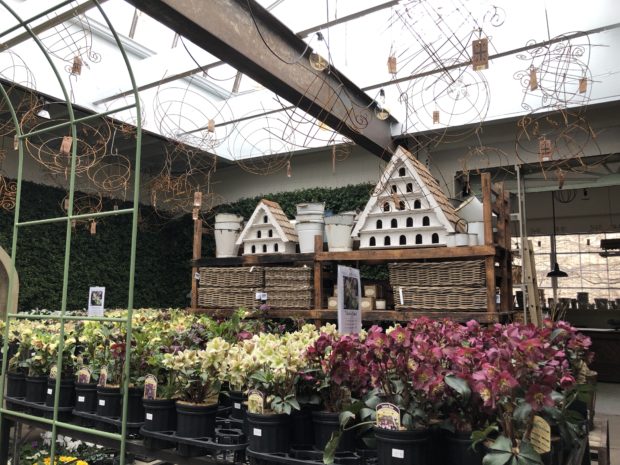 A room full of hellebores does more for the winter weary spirit than anything we can think of. So our spring opening is marked by the coming of the hellebores. But a look at Rob’s spring collection is a close second. As I have been arranging what he has purchased for weeks, I know what is there. The best part of this work is watching someone see it for the first time. For those that read my essays that are too far away to experience our spring collection, I took pictures.
A room full of hellebores does more for the winter weary spirit than anything we can think of. So our spring opening is marked by the coming of the hellebores. But a look at Rob’s spring collection is a close second. As I have been arranging what he has purchased for weeks, I know what is there. The best part of this work is watching someone see it for the first time. For those that read my essays that are too far away to experience our spring collection, I took pictures.
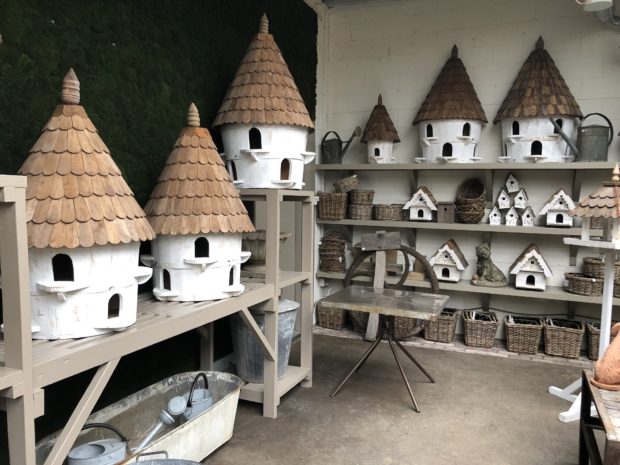 The dovecotes and bird houses are English made in a classical English style, and are available in a wide range of sizes and shapes.
The dovecotes and bird houses are English made in a classical English style, and are available in a wide range of sizes and shapes.
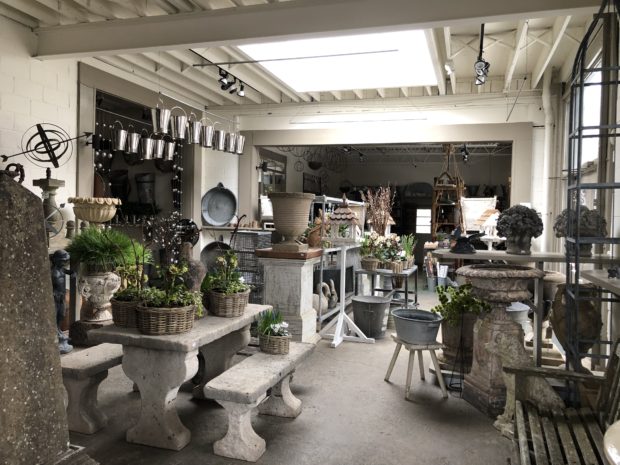 The skylight environment is home to plenty of pots that Rob has planted up featuring hellebores, cyclamen, primula denticulata and obconica, and the Barnhaven series of double primrose.
The skylight environment is home to plenty of pots that Rob has planted up featuring hellebores, cyclamen, primula denticulata and obconica, and the Barnhaven series of double primrose.
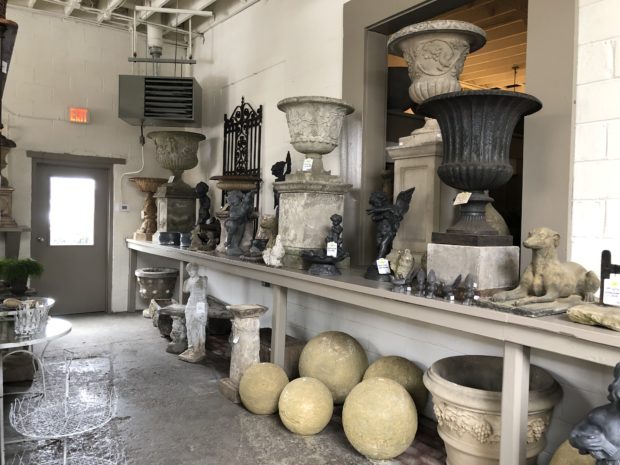 A new collection of lead sculpture and fountains and English stone spheres are kept company with a group of classical urns in stone and iron.
A new collection of lead sculpture and fountains and English stone spheres are kept company with a group of classical urns in stone and iron.
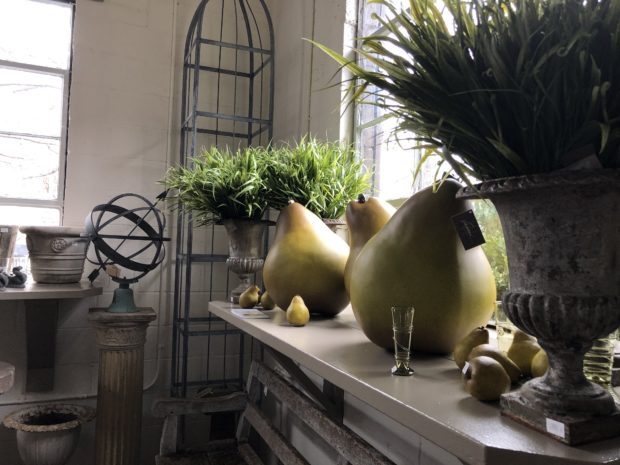 Three English handmade and hand painted pears would be terrific on a covered porch. Iron urns stuffed with faux grasses are destined for spring pots.
Three English handmade and hand painted pears would be terrific on a covered porch. Iron urns stuffed with faux grasses are destined for spring pots.
 I did have to spring for a vase chock full of ranunculus for our opening. How so? Hellebores are a member of the family ranunculaceae .
I did have to spring for a vase chock full of ranunculus for our opening. How so? Hellebores are a member of the family ranunculaceae .
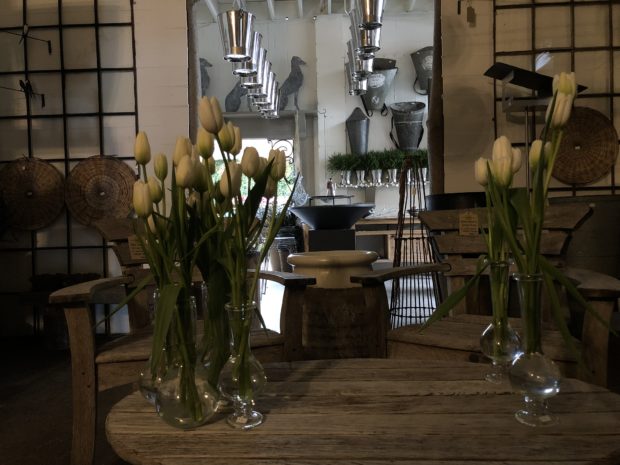 White tulips seemed appropriate for a room that features more contemporary garden ornament.
White tulips seemed appropriate for a room that features more contemporary garden ornament.
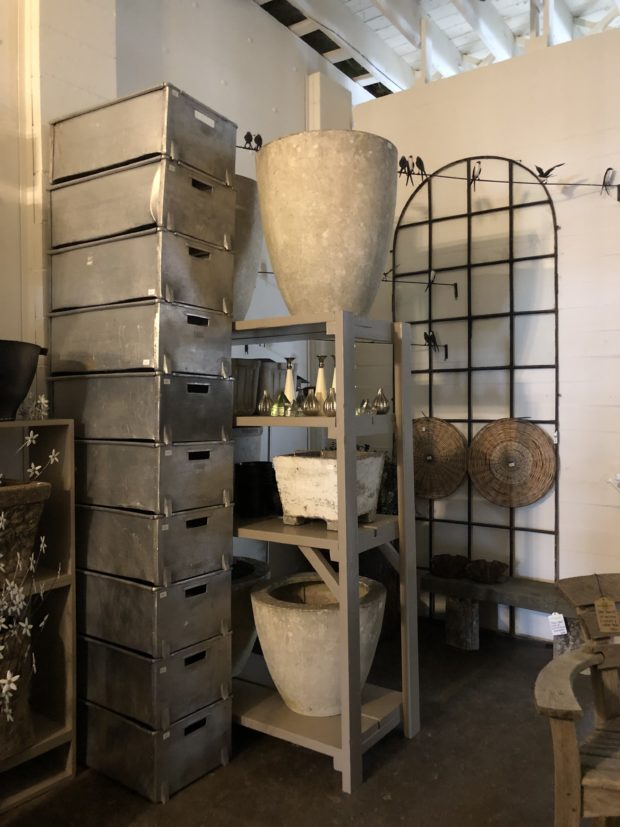 This stack of stainless steel drawers is just waiting for that gardener who has a mind to make them a feature of a contemporary garden. The very large pots are vintage fiberglass. The swallows welded to a 1/4″ thick steel rod come in a five foot, and 11 foot length. Birds on a wire. They are fabricated in France, and come with the mounting hardware.
This stack of stainless steel drawers is just waiting for that gardener who has a mind to make them a feature of a contemporary garden. The very large pots are vintage fiberglass. The swallows welded to a 1/4″ thick steel rod come in a five foot, and 11 foot length. Birds on a wire. They are fabricated in France, and come with the mounting hardware.
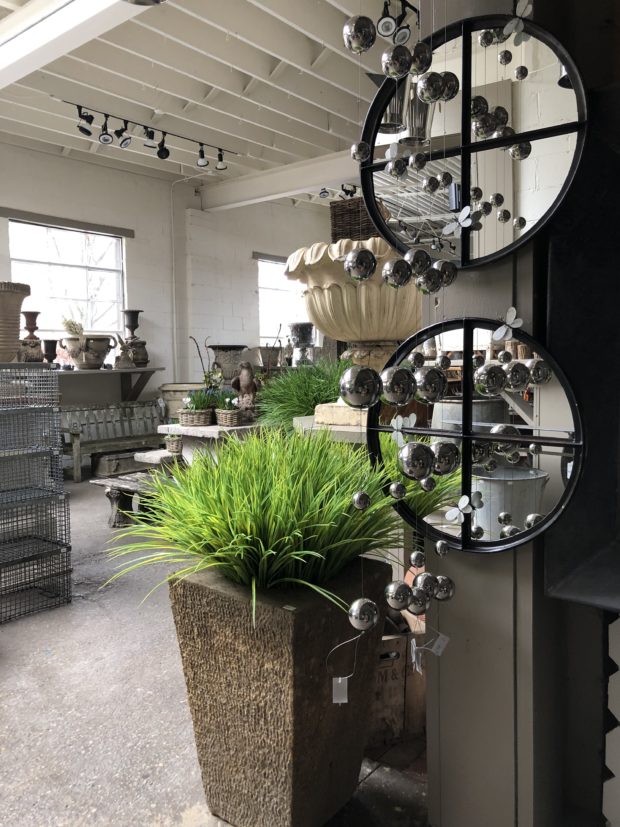 We paired round mirrors with garlands comprised of heavy duty fish line and stainless steel spheres. The chartreuse faux grass is a welcome punch of spring color.
We paired round mirrors with garlands comprised of heavy duty fish line and stainless steel spheres. The chartreuse faux grass is a welcome punch of spring color.
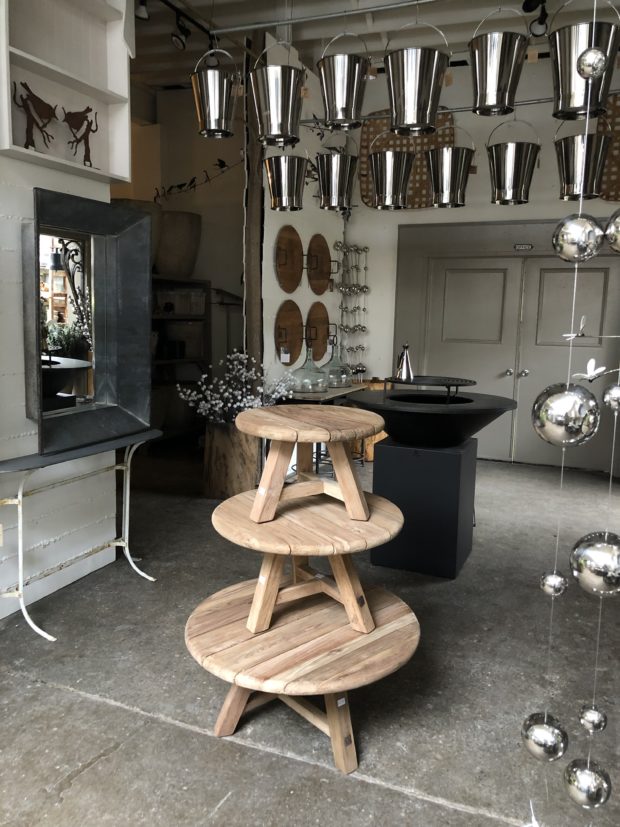 The French company Perigot is known for their iconic buckets. These buckets, available in three sizes, are perfect for a wide range of uses, but I am most fond of the shape, and that beautiful chrome surface. It was a project, hanging them from our ceiling. They are so heavy that we had to thread concrete wire through galvanized pipe to provide a hanging mechanism that would not bow from the weight. The Belgian made teak tables come in four sizes. The zinc framed mirror is a very strong design, and is well made to a fault.
The French company Perigot is known for their iconic buckets. These buckets, available in three sizes, are perfect for a wide range of uses, but I am most fond of the shape, and that beautiful chrome surface. It was a project, hanging them from our ceiling. They are so heavy that we had to thread concrete wire through galvanized pipe to provide a hanging mechanism that would not bow from the weight. The Belgian made teak tables come in four sizes. The zinc framed mirror is a very strong design, and is well made to a fault.
 Vintage zinc grape gathering baskets are a favorite of Rob’s. We have a beautiful collection of them on hand. The smallest of the Perigot buckets look great stuffed with faux grasses. The miniature white painted metal butterflies only require a small nail to hang.
Vintage zinc grape gathering baskets are a favorite of Rob’s. We have a beautiful collection of them on hand. The smallest of the Perigot buckets look great stuffed with faux grasses. The miniature white painted metal butterflies only require a small nail to hang.
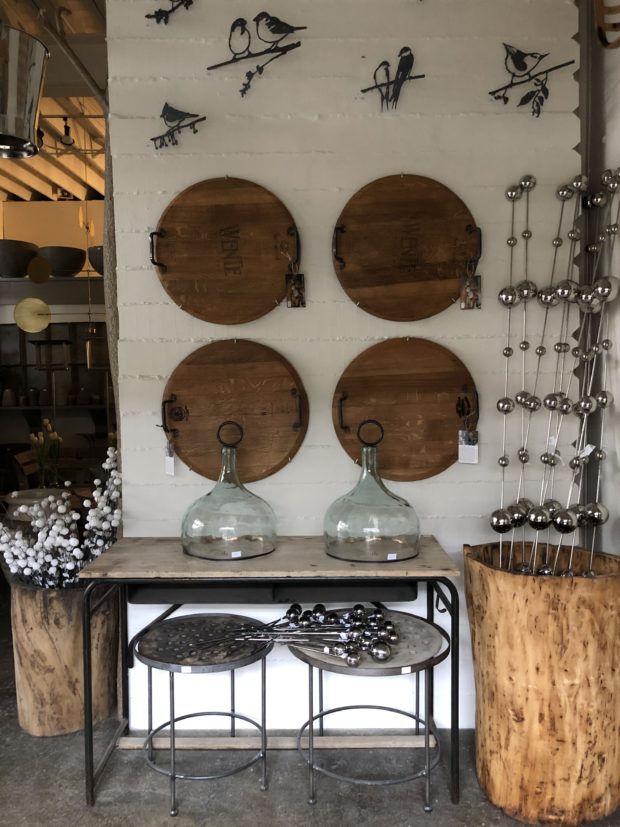 These wood presentation trays are a perennial favorite with our clients. Fashioned from vintage French wine barrel tops and hand forged iron handles by a company in the US, they speak to the idea of the garden as a place to entertain.
These wood presentation trays are a perennial favorite with our clients. Fashioned from vintage French wine barrel tops and hand forged iron handles by a company in the US, they speak to the idea of the garden as a place to entertain. 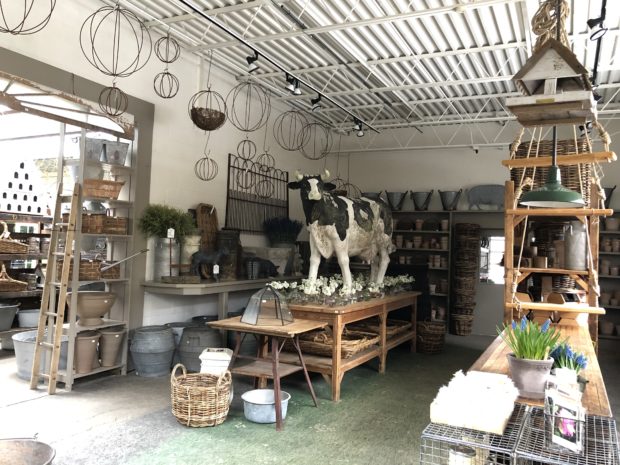 Our better than life size vintage fiberglass cow came with a name. Rob named her Lucy, after a French dealer who was not so interested in letting her go. Rob’s first clue? She was situated in a thriving bed of stinging nettles. How he persuaded Lucy to part with this incredible sculpture is beyond me. How Lucy and her husband got her out of the nettles is unknown to me too.
Our better than life size vintage fiberglass cow came with a name. Rob named her Lucy, after a French dealer who was not so interested in letting her go. Rob’s first clue? She was situated in a thriving bed of stinging nettles. How he persuaded Lucy to part with this incredible sculpture is beyond me. How Lucy and her husband got her out of the nettles is unknown to me too.
 But we are very happy to have her. This is an example of an ornament for the garden that is eminently capable of organizing an entire landscape around her watchful eye. Lucy has an aura.
But we are very happy to have her. This is an example of an ornament for the garden that is eminently capable of organizing an entire landscape around her watchful eye. Lucy has an aura. 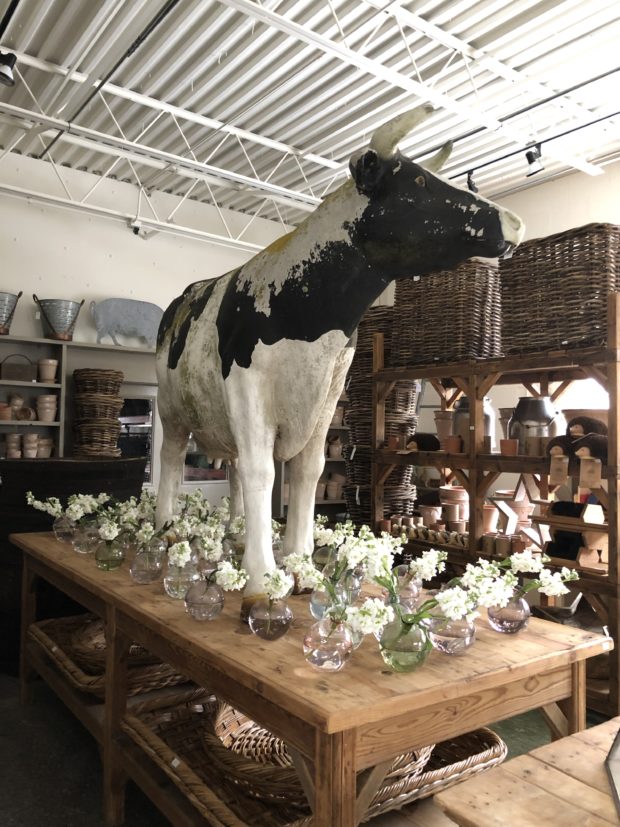 I did fill a collection of spherical vases whose spouts are set on an angle with white stock. Lucy had a fragrant meadow at her feet for our opening.
I did fill a collection of spherical vases whose spouts are set on an angle with white stock. Lucy had a fragrant meadow at her feet for our opening.
 Vintage English chimney pots and milk buckets have beautiful shapes and surfaces.
Vintage English chimney pots and milk buckets have beautiful shapes and surfaces.
 Big baskets woven from thick rattan have a great texture, size, and presence.
Big baskets woven from thick rattan have a great texture, size, and presence.
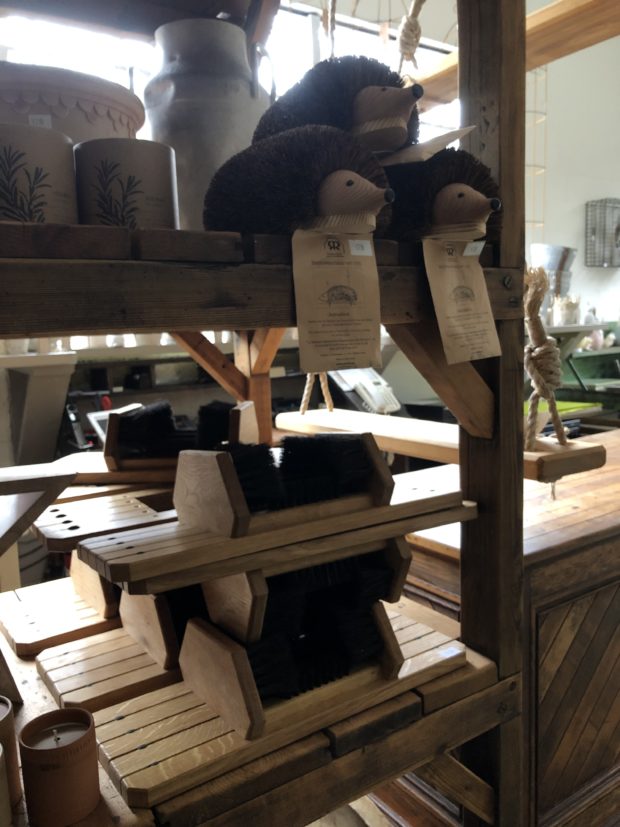 Pardon this poor picture! Serviceable English made bootscrapers are a contrast in form to the hedgehog bootscrapers. Both are made by the same company. If dirty boots are a way of life for you, we have choices.
Pardon this poor picture! Serviceable English made bootscrapers are a contrast in form to the hedgehog bootscrapers. Both are made by the same company. If dirty boots are a way of life for you, we have choices.
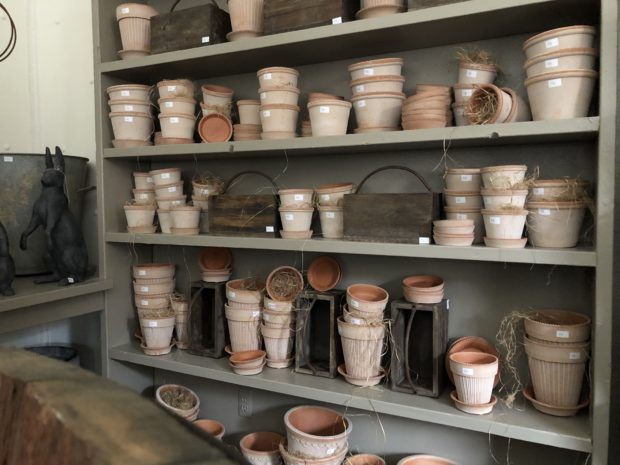 Danish designed pots made in Italy-these are beautiful. The creamy peach color of the clay is beautiful.
Danish designed pots made in Italy-these are beautiful. The creamy peach color of the clay is beautiful.
 This is just part of Rob’s collection from his shop fest in England. The vintage bootscraper with a stout stone base and rusted iron scraping mechanism-a one of a kind.
This is just part of Rob’s collection from his shop fest in England. The vintage bootscraper with a stout stone base and rusted iron scraping mechanism-a one of a kind.
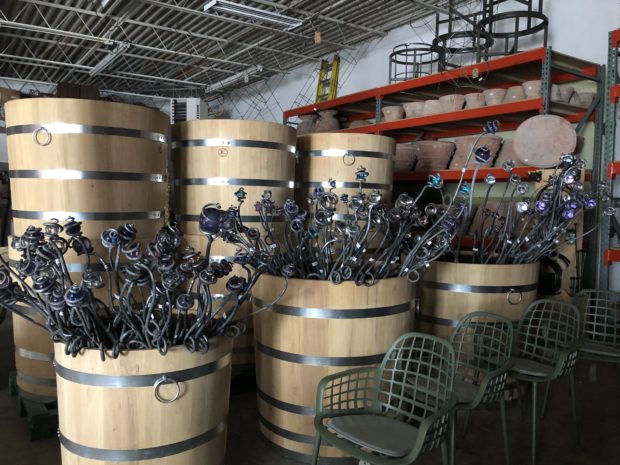 These locust wood casks are made in Belgium. They come in four sizes. Impervious to weather or rot from water, they invite any gardener to plant away. For now they are home to a collection of English made iron garden stakes in various sizes set with glass globes at the top. I predict we will not have these for long.
These locust wood casks are made in Belgium. They come in four sizes. Impervious to weather or rot from water, they invite any gardener to plant away. For now they are home to a collection of English made iron garden stakes in various sizes set with glass globes at the top. I predict we will not have these for long.
 The orange table and chairs are manufactured in Portugal.
The orange table and chairs are manufactured in Portugal.
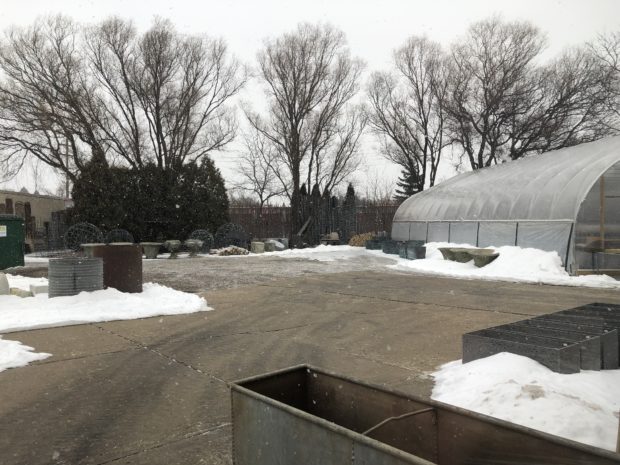 Though the winter weather still has all of us in its grip, there is a taste of spring available at the shop.
Though the winter weather still has all of us in its grip, there is a taste of spring available at the shop.
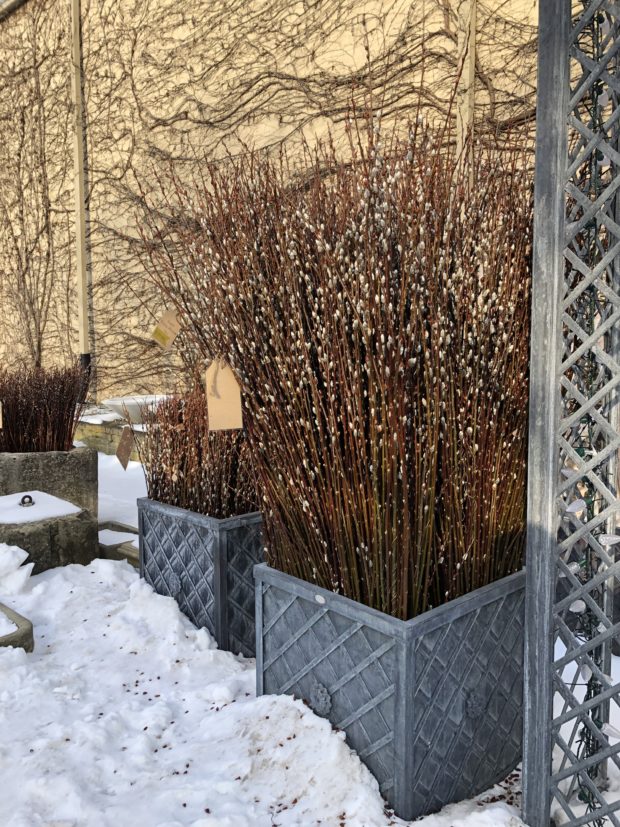 cut pussy willow stems for spring pots
cut pussy willow stems for spring pots
 strikingly beautiful and tall fan willow
strikingly beautiful and tall fan willow
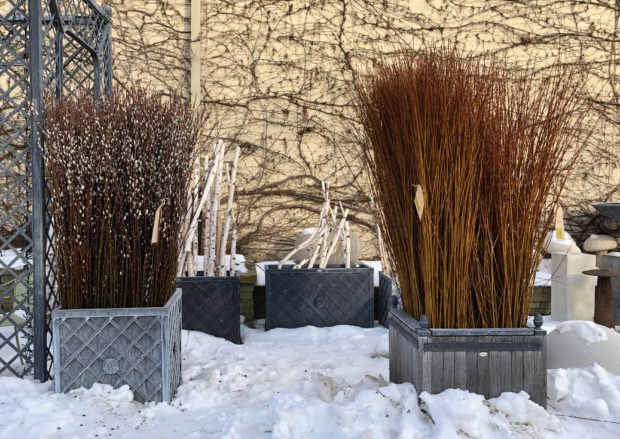 Yes, the spring branches have snow at the base of their pots. They are weathering this late winter blast as I expected. They shrug it off. We can too.
Yes, the spring branches have snow at the base of their pots. They are weathering this late winter blast as I expected. They shrug it off. We can too.
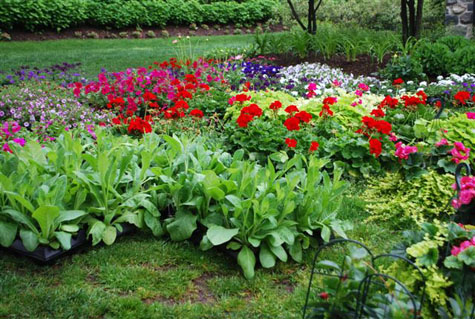 Thank heavens it has a different color scheme and feeling every year. My clients like tinkering with this as much as I do. Its plenty to plan-how many of this, and how many of that. Despite a fleet of trucks, we have plant material delivered. I invariably forget something, or think I have something reserved that’s not there. So we make changes.
Thank heavens it has a different color scheme and feeling every year. My clients like tinkering with this as much as I do. Its plenty to plan-how many of this, and how many of that. Despite a fleet of trucks, we have plant material delivered. I invariably forget something, or think I have something reserved that’s not there. So we make changes.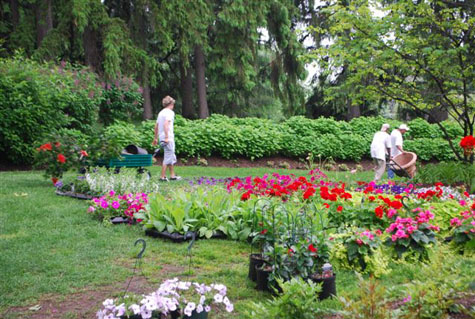 This works for us-photo copies of last years pots and beds have the new scheme written on them. I don’t need to do much for Diana after all her years, except list the plants. Should I leave something out, or have too much, she knows how to adjust.
This works for us-photo copies of last years pots and beds have the new scheme written on them. I don’t need to do much for Diana after all her years, except list the plants. Should I leave something out, or have too much, she knows how to adjust.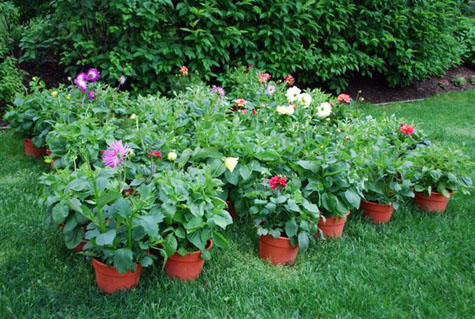 My client’s love of dahlias always presents transport troubles. This year Carlson’s greenhouse grew all the tall dahlias from cuttings. This makes the plant bushy from the start-as opposed to tall dahlias started from tubers. These short and chunky plants are easy to ship, and easier to plant. Let the sun and rain do the job of getting them tall, with those dinnerplate size flowers.
My client’s love of dahlias always presents transport troubles. This year Carlson’s greenhouse grew all the tall dahlias from cuttings. This makes the plant bushy from the start-as opposed to tall dahlias started from tubers. These short and chunky plants are easy to ship, and easier to plant. Let the sun and rain do the job of getting them tall, with those dinnerplate size flowers. Giant wirework urns are mossed and planted at the shop; these get delivered, finished, and ready to place. As they are tall, and some are viewed at a distance, I plant simply, and with good contrast.
Giant wirework urns are mossed and planted at the shop; these get delivered, finished, and ready to place. As they are tall, and some are viewed at a distance, I plant simply, and with good contrast.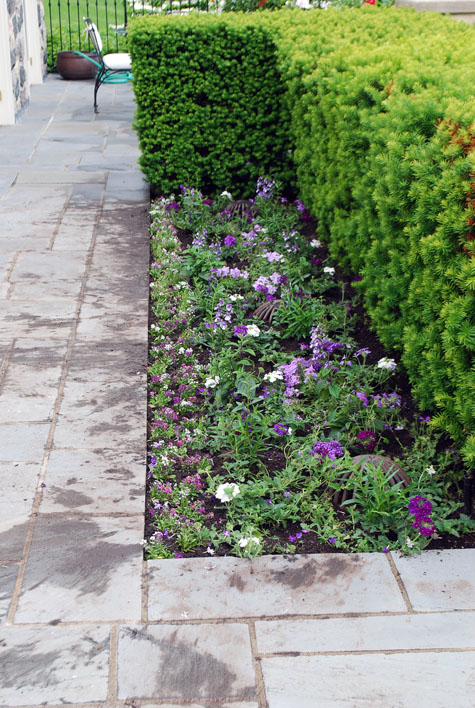 We plant beds backed up by mature and formal yew hedges with a low mix of annuals. The yews are not a backdrop; they are the feature. The little babble of trailing verbena and alyssum, heliotrope and angelonia is in stark contrast to those massive dark green yews.
We plant beds backed up by mature and formal yew hedges with a low mix of annuals. The yews are not a backdrop; they are the feature. The little babble of trailing verbena and alyssum, heliotrope and angelonia is in stark contrast to those massive dark green yews. We plant mandevillea vines, tropical hibiscus trees on standard, zinnias, New Guinea impatiens, and the dahlias-all in response to my client’s love of big flowers.
We plant mandevillea vines, tropical hibiscus trees on standard, zinnias, New Guinea impatiens, and the dahlias-all in response to my client’s love of big flowers.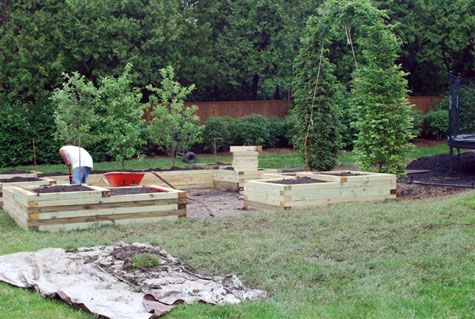 For years we have planted the vegetable garden in giant fiber pots. This year we have a formal vegetable garden under construction-the highlight of which is a European beech arbor 14 feet tall.
For years we have planted the vegetable garden in giant fiber pots. This year we have a formal vegetable garden under construction-the highlight of which is a European beech arbor 14 feet tall.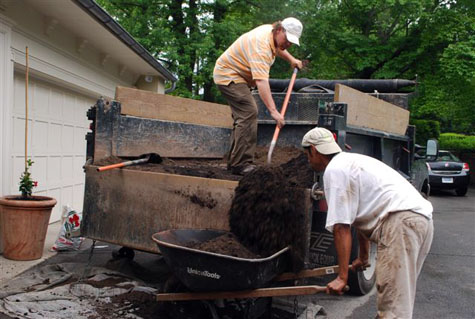
 Texture is such an exciting element in plants-and plantings. Defined by Wikipedia as “an identifying quality”, or the “appearance and feel of a surface”, the texture of a plant can be about its appearance. Some plants are shiny leaved; some have felted leaves. Some leaves and flowers are thin (sometimes referred to as “substance”) and some are thick and juicy looking. Some leaves are wisy and airy looking-others are big and broad-and look as though even a big wind wouldn’t disturb them. This kale is ultra-crinkled-beautiful.
Texture is such an exciting element in plants-and plantings. Defined by Wikipedia as “an identifying quality”, or the “appearance and feel of a surface”, the texture of a plant can be about its appearance. Some plants are shiny leaved; some have felted leaves. Some leaves and flowers are thin (sometimes referred to as “substance”) and some are thick and juicy looking. Some leaves are wisy and airy looking-others are big and broad-and look as though even a big wind wouldn’t disturb them. This kale is ultra-crinkled-beautiful.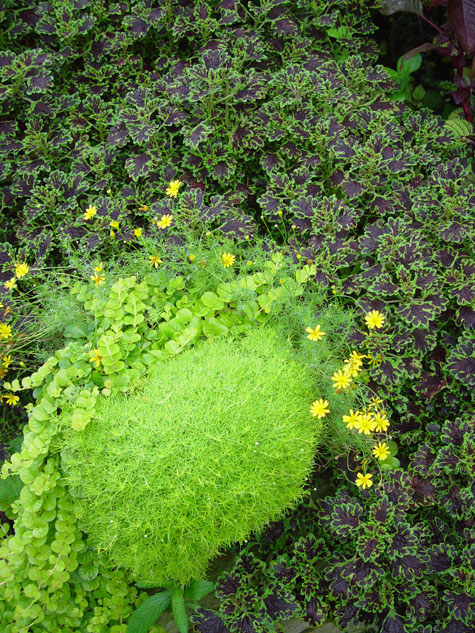 Texture can also refer to how a plant feels to the touch-who could resist touching this scotch moss? Contrasting textures can make for a lot of excitement in a planting-but even the relationship of one small texture to another can be interesting.
Texture can also refer to how a plant feels to the touch-who could resist touching this scotch moss? Contrasting textures can make for a lot of excitement in a planting-but even the relationship of one small texture to another can be interesting.  Some plantings where all the textures read similarly encourage focus on color, or mass. The choice of plants very much dictates what about a plant or planting becomes the dominant element. This box of grass, euphorbia Diamond Frost, thyme and sedum has that casual roadside weed look to it. You notice the blue of the sedum first off, as the textures of all the plants are so similar. There is a whole story here about little leaves.
Some plantings where all the textures read similarly encourage focus on color, or mass. The choice of plants very much dictates what about a plant or planting becomes the dominant element. This box of grass, euphorbia Diamond Frost, thyme and sedum has that casual roadside weed look to it. You notice the blue of the sedum first off, as the textures of all the plants are so similar. There is a whole story here about little leaves. 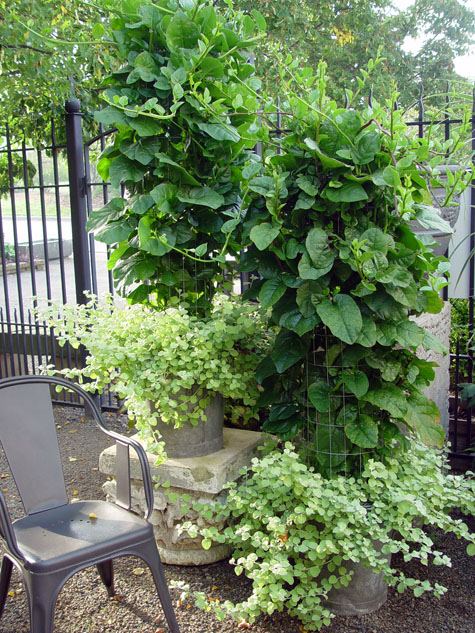 Malabar spinach has thick, substantial leaves that are glossy and wrinkled. This texture reads all the more strongly for its pairing with the diminuitive felted stems and leaves of lime licorice.
Malabar spinach has thick, substantial leaves that are glossy and wrinkled. This texture reads all the more strongly for its pairing with the diminuitive felted stems and leaves of lime licorice. 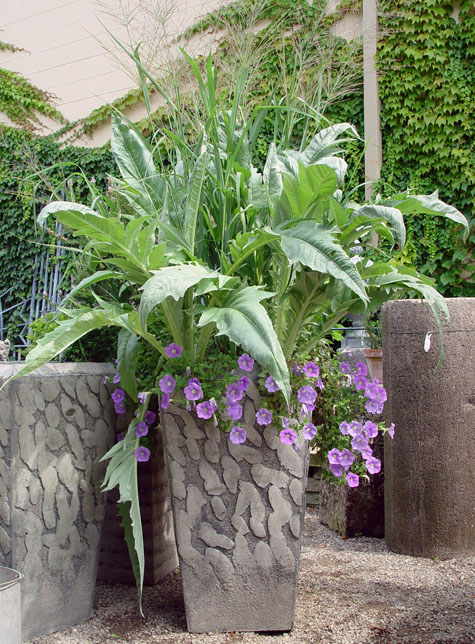 The hunky, toothy, slighting menacing leaves of this cardoon are softened by the much less architectural “Dallas Blues” panicum grass-and the so sweet blue petunias. The cardoon has a felted leaf-the panic grass is smooth and shiny. Those blue petunias are along for the ride-and soften much the architecture of the cardoon-and the pot.
The hunky, toothy, slighting menacing leaves of this cardoon are softened by the much less architectural “Dallas Blues” panicum grass-and the so sweet blue petunias. The cardoon has a felted leaf-the panic grass is smooth and shiny. Those blue petunias are along for the ride-and soften much the architecture of the cardoon-and the pot.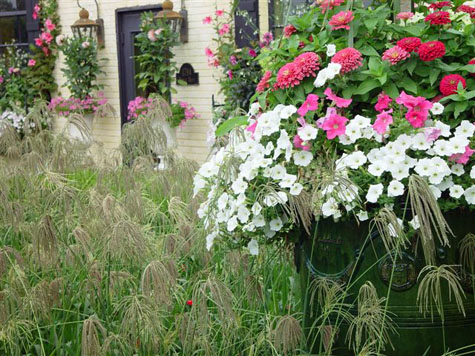 Large flowers like zinnias and petunias have a simple texture, while its companion grass has a complex, texture-like fireworks. Diametrically opposed to this delicately textured grass, caladiums and this lime dieffenbachia have leaves so thin and so wide the sun shines through them; it looks like the lights are on in this very shady spot. Identifying what about a particular plant you like will help a lot to inform your design with them. Everyone knows texture. Its the process of being conscious of it that can help make for inspired plantings .
Large flowers like zinnias and petunias have a simple texture, while its companion grass has a complex, texture-like fireworks. Diametrically opposed to this delicately textured grass, caladiums and this lime dieffenbachia have leaves so thin and so wide the sun shines through them; it looks like the lights are on in this very shady spot. Identifying what about a particular plant you like will help a lot to inform your design with them. Everyone knows texture. Its the process of being conscious of it that can help make for inspired plantings .